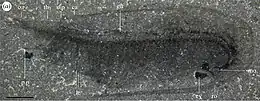Fibulacaris
Fibulacaris is a monotypic genus of fossil arthropod known only by one species, Fibulacaris nereidis, discovered from the Cambrian Burgess Shale of Canada.[1] It was characterized by a bivalved carapace with an inverted rostrum, sandwiching the slender body with stalked eyes and homonomous appendages.[1] It was probably an actively swimming filter feeder and possibly swam upside-down like some branchiopod crustaceans and horseshoe crabs.[1] Phylogenetic analysis suggest it was a relative or member of Hymenocarina, which contains other bivalved arthropods.[1][2]
| Fibulacaris Temporal range: | |
|---|---|
 | |
| Holotype specimen of Fibulacaris nereidis (ROMIP 65380) | |
 | |
| Diagram | |
| Scientific classification | |
| Kingdom: | |
| Phylum: | |
| Order: | |
| Genus: | Fibulacaris Izquierdo-López & Caron, 2019 |

Life restoration
References
- Izquierdo-López, Alejandro; Caron, Jean-Bernard (2019). "A possible case of inverted lifestyle in a new bivalved arthropod from the Burgess Shale". Royal Society Open Science. 6 (11): 191350. Bibcode:2019RSOS....691350I. doi:10.1098/rsos.191350. PMC 6894550. PMID 31827867.
- Izquierdo‐López, Alejandro; Caron, Jean‐Bernard (2021). Zhang, Xi‐Guang (ed.). "A Burgess Shale mandibulate arthropod with a pygidium: a case of convergent evolution". Papers in Palaeontology. 7 (4): 1877–1894. doi:10.1002/spp2.1366. ISSN 2056-2799. S2CID 236284813.
This article is issued from Wikipedia. The text is licensed under Creative Commons - Attribution - Sharealike. Additional terms may apply for the media files.
